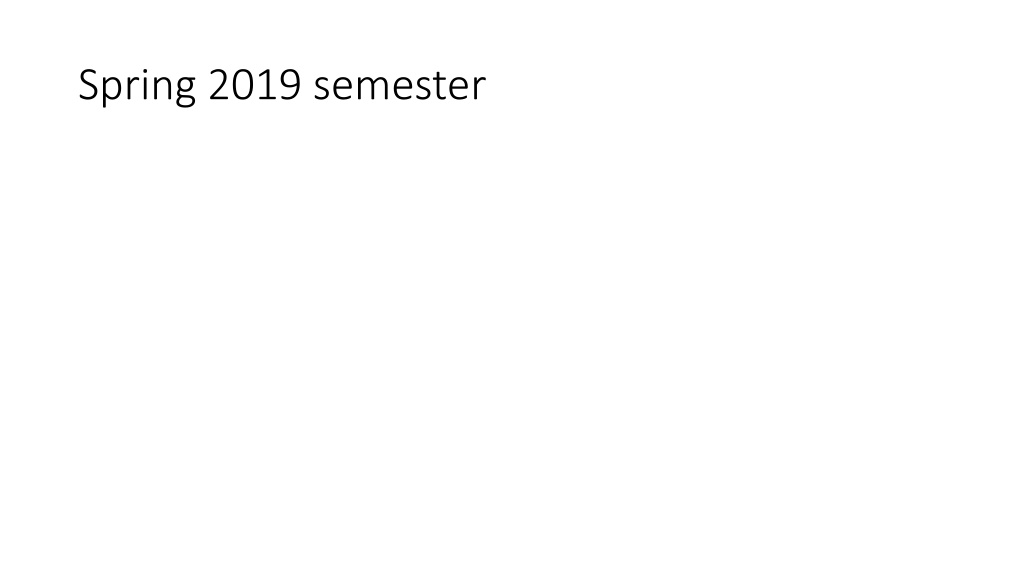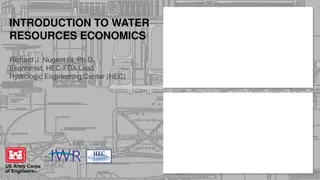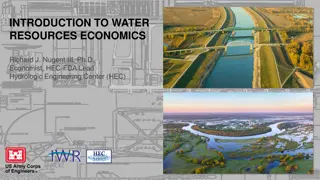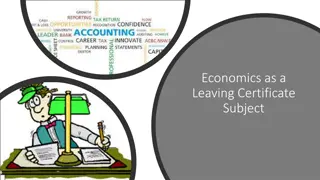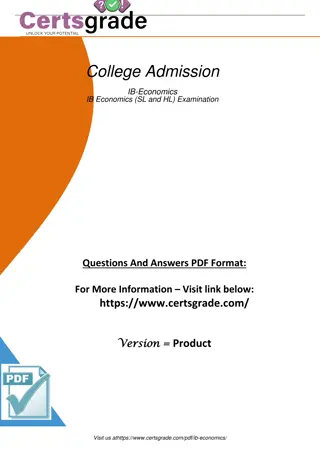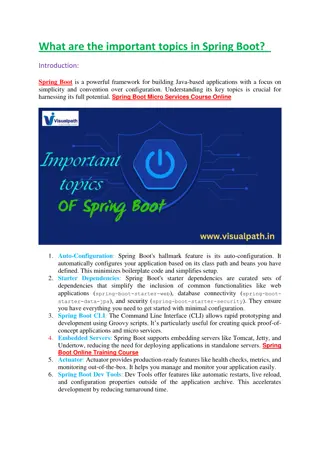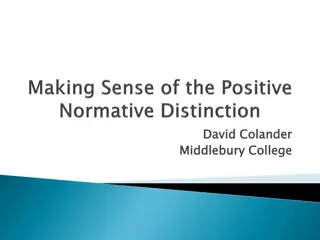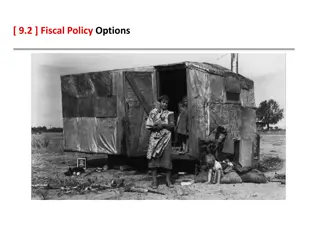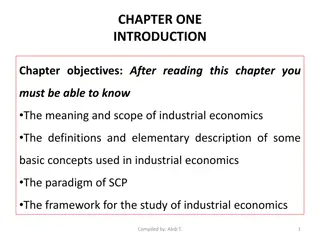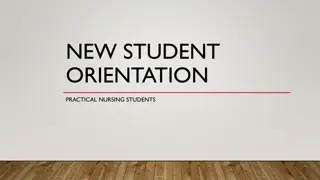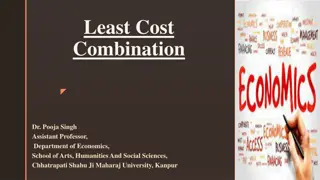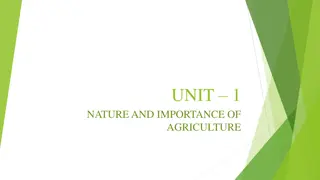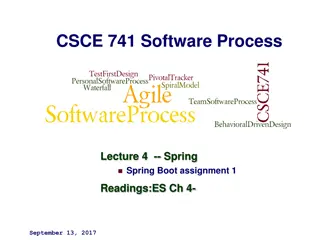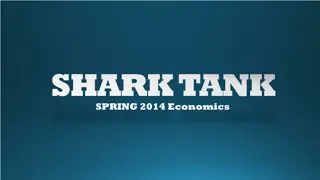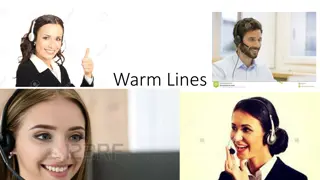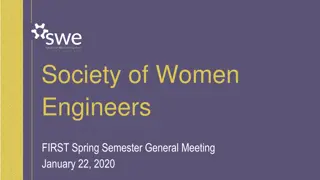Economics Warm-Up Questions Spring 2019 Semester
In the Spring 2019 semester, various economics warm-up questions were discussed focusing on topics like scarcity, rational decision making, opportunity cost, and voluntary exchange. Students engaged in thought-provoking scenarios and multiple-choice questions that challenged their understanding of economic concepts.
Uploaded on Sep 06, 2024 | 1 Views
Download Presentation

Please find below an Image/Link to download the presentation.
The content on the website is provided AS IS for your information and personal use only. It may not be sold, licensed, or shared on other websites without obtaining consent from the author.If you encounter any issues during the download, it is possible that the publisher has removed the file from their server.
You are allowed to download the files provided on this website for personal or commercial use, subject to the condition that they are used lawfully. All files are the property of their respective owners.
The content on the website is provided AS IS for your information and personal use only. It may not be sold, licensed, or shared on other websites without obtaining consent from the author.
E N D
Presentation Transcript
2/25: Economics warm up #1 (test grade) Imagine you are traveling on a boat across the world with all of your possessions. Suddenly your boat is about to sink. You can only bring 10 items with you on a life boat to a deserted island. What 10 items will you bring to the island? 1. 5. 2. 6. 3. 7. 4. 8. 9. 10.
2/26, warm up question #2 (test grade) 2/26, warm up question #2 (test grade) Which of the following statements BEST defines scarcity? a) A condition that exists when tax revenue exceeds government expenditures b) A shortage of money to purchase goods and services c) A condition when marginal costs outweigh marginal benefits d) A basic condition that exists when unlimited wants exceed limited resources
2/28 warm up #3 (test grade) When making a rational decision, the a) Marginal benefits have to be less than the marginal costs b) Marginal costs have to be greater than the marginal benefits c) Marginal benefits have to greater than the marginal costs d) Marginal costs have to be equal to the opportunity costs
3/1, warm up question #4 (draw and label graph) 3/1, warm up question #4 (draw and label graph) What is the opportunity cost when going from point A to point C? a) capital goods b) consumer goods c) both capital and consumer goods d) none of the above
3/5/19 warm up #5 Sarah has a cookie and Tom has an apple for a snack in their respective lunch bags. Sarah and Tom trade snacks. This is an example of voluntary exchange because a) Both parties benefitted b) They willingly traded for the item c) The teacher forced them to trade snacks at lunch d) Both of them felt they gained an item of greater value at the time e) Both A and B f) Both B and C g) A, B, and D h) A, B, C
3/7 warm up question #6 (test grade) What is the relationship between specialization and voluntary exchange? a) Voluntary Exchange negates the need for specialization b) Voluntary Exchange causes specialization c) Specialization leads to a need for voluntary exchange d) Specialization exists because of voluntary exchange
Warm up #7 (test grade) Government agencies inspect restaurants on a regular basis to ensure the restaurants are obeying health and food safety regulations. What economic effect does this have on the restaurants? a) Restaurants make more profits because the government takes fewer taxes when they meet regulations b) More food is produced because the regulations make the restaurant more productive and efficient. c) They charge higher prices to cover the costs of the time and resources used in meeting the regulations
Warm up question #8, 3/14 When should this business stop hiring workers? A. 2 B. 3 C. 4 # of workers Marginal Cost (pay workers) Marginal Benefit (profit earned from them) 1 2 3 4 $500 $500 $500 $500 -$50 $200 $100 -$50
3/15 warm up #9 Why do people save and invest their money? a) Pay off credit card debt b) Save money to extend their credit limit c) Retirement and future purchases d) Be prepared for high tax rates e) Be able to afford variable interest rates
3/15 warm up #10 How do banks earn profits? a) Have low interest charged on loans, pay high interest on customer deposits b) Have high interest charged on loans, pay low interest on customer deposits c) Charge simple interest on a loan d) Borrow money from the government to grow their balance sheet
3/19 warm up #11 Susan deposits money into her savings account, earning .5%. Later that week, she decides to take out a loan from her bank. Her interest rate on her loan will be _________ than .5%. a) Lower b)Higher c) The same
3/19 warm up #12 Who benefits from unanticipated inflation? a) Lenders b)Borrowers c) People on fixed incomes d)Low income earners
Warm up question #13, 3/21/19 -Have collateral -Punctual payments -Have steady income These factors will MOST LIKELY get you a a) Low credit score, below 700 b) High credit score, above 700 c) High credit score, below 300 d) Low credit score, about 600
Warm up question #14 Most insurance companies include a stipulated amount of money that the insured must pay when a claim is filed with the insurance company, which is called ___________. a) Shared liability b) Deductible c) Premium d) Asset protection
3/25 warm up #15 Kelvin makes $50K per year and Kirby makes $30K per year. Kelvin pays a higher average tax rate on his income than Kirby. This infers that the income taxes are a) Regressive b) Proportional c) Progressive d) Marginal
3/25 warm up #16 Bank 1 Bank 2 Bank 3 Bank 4 7.5% APR 19% APR 22% APR 0% APR $40 annual fee $0 annual fee $20 annual fee $100 annual fee Assuming you pay off your credit card each month, which credit card would you sign up for? A. Bank 1 B. Bank 2 C. Bank 3 D. Bank 4
3/25 warm up #17 Typically, as risk of losing money on an investment increases a) The chance of getting a greater return decreases b) People put more money in that investment c) There is less incentive to put money in that investment d) The chance of getting a greater return increases
Warm up #18, 3/26/19 When you buy insurance you have a trade off between your deductible and premium. If you have a ______ deductible, the insurance company makes you pay for the risk with a _______ premium. a) High; low b) Low; high c) High; high d) Low; low
warm up question #19 In the ________ market, businesses purchase factors of production. In the ________ market, households purchase finished goods and services. a) Product; Factor b) Government; Product c) Factor; Product d) Factor; Government
3/29/19 warm up question #20 The market clearing price, or equilibrium price, is the point at which supply equals demand. If the government sets a price above the equilibrium, it creates a ___________. If the price is set below the equilibrium, it creates a ________. a) Surplus; shortage b) Shortage; surplus c) Surplus; surplus d) Shortage; shortage
warm up #21 (23 days until the EOC) A market structure that has little control over price and requires a lot of advertising because there are many firms that sell a similar products (like clothing stores) is a) Monopolistic competition b) An Oligopoly c) A Monopoly d) Perfect Competition
4/12 warm up #22 (20 days left until the EOC) The RELIANCE on one another to provide the goods/services that people need: a) Factor market b) Economic interdependence c) Businesses d) Law of Demand
Warm up #23 If there is an increase in the number of sellers in a market, we would expect a) Supply to decrease b) Supply to increase c) Supply to remain unchanged d) Supply could increase or decrease
Warm up #24 When buyers and sellers interact in the market, what is the result? a) Fewer goods are produced because buyers own all that they want b) Equilibrium quantities are determined, but prices are set by the government c) Usually a market clearing price is determined
4/15 warm up #25 Which of the following is TRUE about GDP? a) It measures inflation; it includes consumer spending, government spending, and net imports b) It measures economic growth; it includes consumer spending, government spending, capital investments, and net imports c) It measures economic growth, it includes consumer spending, government spending, capital investments, and net exports
Warm up question #26, 4/17/19 Warm up question #26, 4/17/19 Which of the following would economists consider a healthy economy? a) 2% inflation, 10% unemployment, 3% GDP growth b)5% inflation, 5% unemployment, 2% GDP growth c) 2% inflation, 4% unemployment, 80% GDP growth d)2% inflation, 4% unemployment, 3% GDP growth
Warm up #27 Warm up #27 What impact does expansionary fiscal policy have on GDP, Aggregate Demand, Unemployment, and CPI? a) GDP goes up, AD goes up, Unemployment goes down, CPI goes up b) GDP goes up, AD goes up, Unemployment goes up, CPI goes down
Warm up #28 4/18 (16 days left until EOC) If the economy is experiencing a long recession or trough, which action might the Federal Reserve take? a) Expansionary monetary policy- increase the money supply, which raises interest rates and boosts spending b) Expansionary monetary policy- increase the money supply, which lowers interest rates and boosts spending c) Contractionary monetary policy- lower the money supply, which lowers interest rates and boosts spending
Warm up #29 (7 days left until the EOC!!!) The Federal Reserve impacts ________ ________. If they go up, it is _________ ________ to borrow money from banks. a) Savings accounts; less expensive b) Interest rates; more expensive c) Interest rates, less expensive
Warm up #30 (last warm up, turn in for test grade) Warm up #30 (last warm up, turn in for test grade) Which of the following scenarios BEST describes a positive incentive? a) The FED raises interest rates in order to boost consumer borrowing and spending b) Congress and the President raises corporate taxes so more workers can be hired c) Businesses lower prices to try and boost consumer demand d) The U.S. raises tariffs on Chinese imports to allow for more products to reach American households
